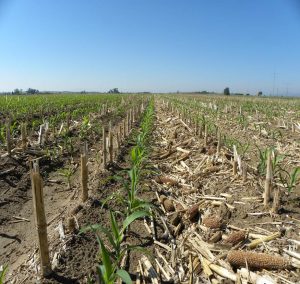Soil erosion can impact water quality by transporting soil sediments and the attached nutrients and chemicals into surface waterways. Soil erosion also results in the loss of fertile topsoil and reduces cropland productivity.
Utilizing better tillage and residue management practices can improve soil structure to more efficiently use nutrients and water.

Soil Erosion Facts
- Agricultural soil erosion is the wearing away of topsoil caused by wind, water, and human activities.
- The natural development of topsoil is a very slow process.
- Water erosion can be caused by both natural precipitation and applied irrigation.
- Erosion is more likely on sloped, bare, and saturated soils.
Soil Erosion Control BMPs

FAQ
Why is soil erosion management important to managing nutrients and other water quality issues?
Soil erosion can result in the loss of soil sediments from cropland to surface waterways. Soil sediments are a contaminant in addition to the nutrients and other chemicals that can be attached to soil sediments. In addition, utilizing better tillage and residue management practices can improve soil structure to more efficiently use nutrients and water.
What are best management practices (BMPs)?
Best management practices, or BMPs, are recommended structures, methods, and practices designed to protect water quality. BMPs can provide environmental, agronomic, and economic benefits.
The cost, economic return, ease of implementation, and overall effectiveness will vary from practice to practice. Recommended BMPs may include already widely accepted and utilized agricultural practices.
Every farm is unique and requires a particular combination of practices that meets the needs of the land and the producer.
What is conservation tillage?
Conservation tillage refers to tillage and planting systems that maintain at least 30% of the soil surface covered by residue following planting, or a system that maintains at least 1,000 pounds per acre of small grain residue on the surface during the critical erosion period.
What are the drawbacks of conventional tillage?
Conventional tillage (or clean tillage) often results in overtilled soils, which causes the loss of organic matter and the breakdown of soil structure. Clean tillage can also promote soil erosion, create soil compaction, increase soil moisture loss, as well as increase labor and production costs.
What are the benefits of conservation tillage?
- Reduce/eliminate field operations, which reduces production costs and soil compaction
- Reduces soil erosion caused by wind and water, which maintains crop production sustainability and protects water quality
- Improves soil structure, which promote efficient use of nutrients and water
- Provides wildlife shelter and habitat

